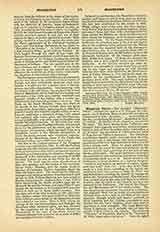

Malpighi, MARCELLO, founder of comparative physiology, b. at Crevalcore, March 10, 1628; d. at Rome, September 29, 1694. The year of his birth was that of the publication of Harvey’s book on the circulation of the blood, a work which Malpighi was destined to complete by his observations on the capillaries. Brought up on the paternal farm, he became at the age of about seventeen a student at the University of Bologna. He devoted himself to philosophy, but during the last year of his undergraduate course his father, mother, and paternal grandmother died. As he was the eldest of the children, and the next three were girls, he had to leave the university to settle the financial affairs of the family. It was more than two years before he could resume his studies, and then he had to take up a profession that would enable him to help the family. In the medical school Malpighi attracted the attention of Professor Massari, who was not only a teacher but an investigator, and in 1653 obtained the degree of doctor in medicine and philosophy. The following year he married Francesca Massari, younger and favorite sister of his distinguished professor, who died the year after. Malpighi’s independence of thought, and his refusal to follow Galen blindly, aroused opposition. Still, he was offered in 1656 the chair of medical practice at the university, and, towards the end of the same year, a special chair of theoretical medicine was created for him at the recently established University of Pisa. After three years’ work at Pisa he returned to Bologna, and two years later was called to the University of Messina in Sicily. Here he remained four years, and, on his return to Bologna, was greeted as one of her greatest citizens.
Everything that Malpighi had touched had meanwhile turned to science. He had used the microscope on human tissues with such good effect that one of the layers of the skin is still called the rete Malpighi; certain bodies in the spleen and in the kidneys are called by his name, and important discoveries in the liver are due to him. The first good comparative study of the liver, from the snail through the fishes, reptiles, and mammals up to man, is due to Malpighi, and he was the first to give an adequate description of the formation of the chick in the egg. One day he studied the jagged bark of a green branch, and found little vessels in the wood. His study of the capillary circulation in man gave him an interest in this, and the result was his book on the anatomy of plants, which was published by the Royal Society of England (“Anatome plantarum idea”, London, 1675). The Royal Society suggested his study of silk-worms. This book is still consulted, though Malpighi had few aids for such minute anatomy at that time. When he was about sixty-four and at the height of his fame, Pope Innocent XII, who had been his personal friend, invited him to Rome as papal physician and professor of medicine in the Papal Medical School. He was held in high honor during his last years, and died there of apoplexy in the sixty-seventh year of his age.
JAMES J. WALSH

